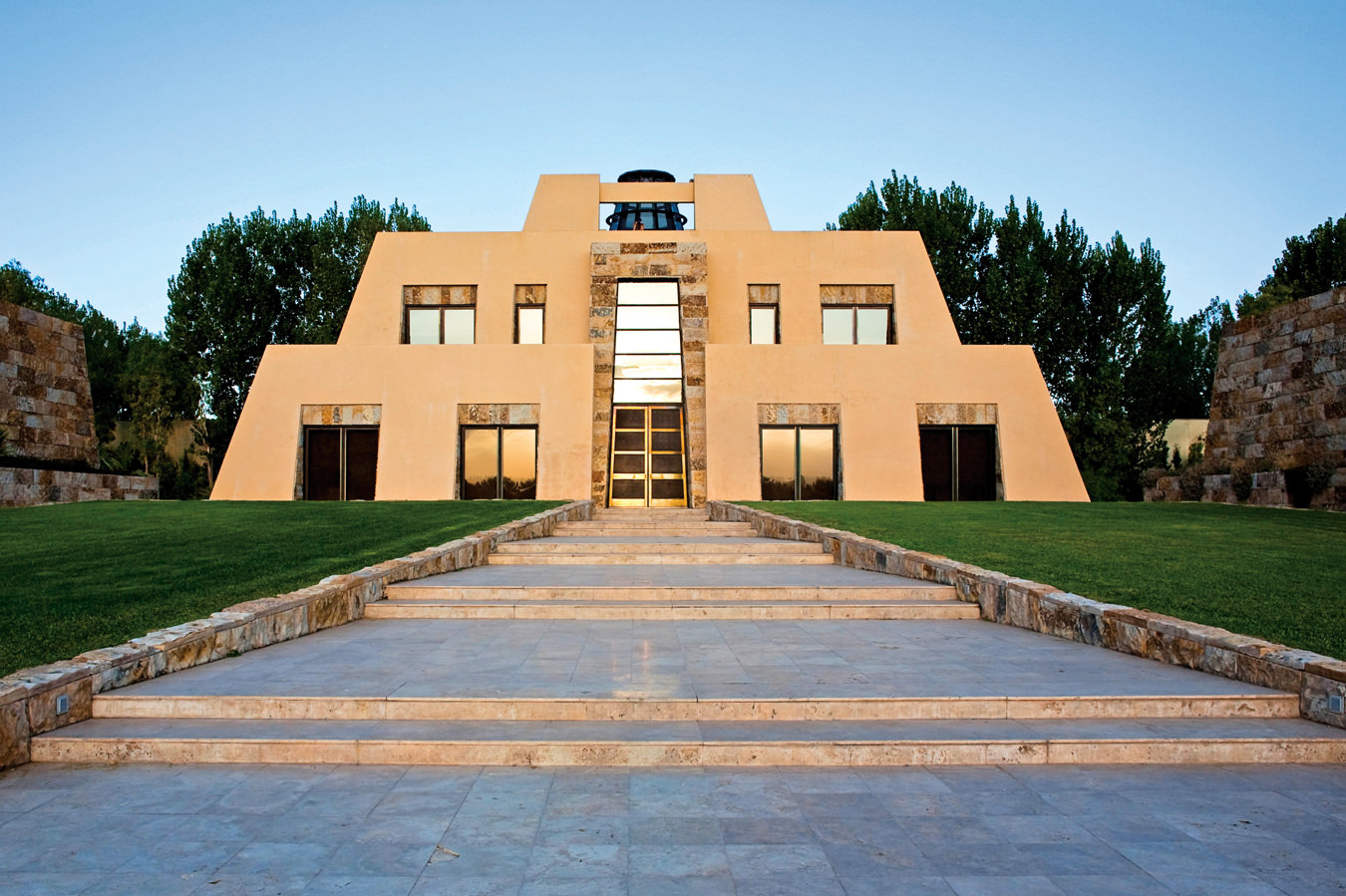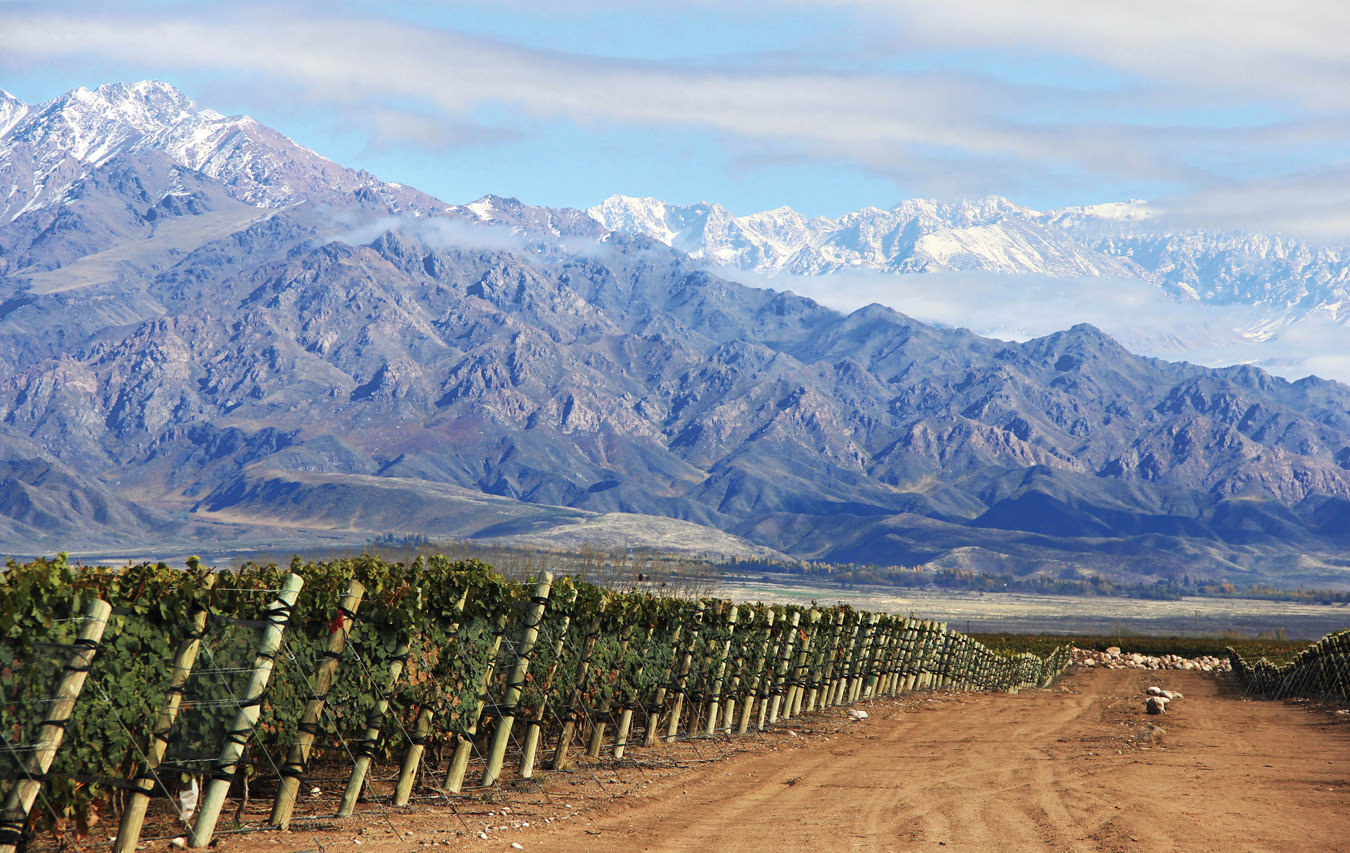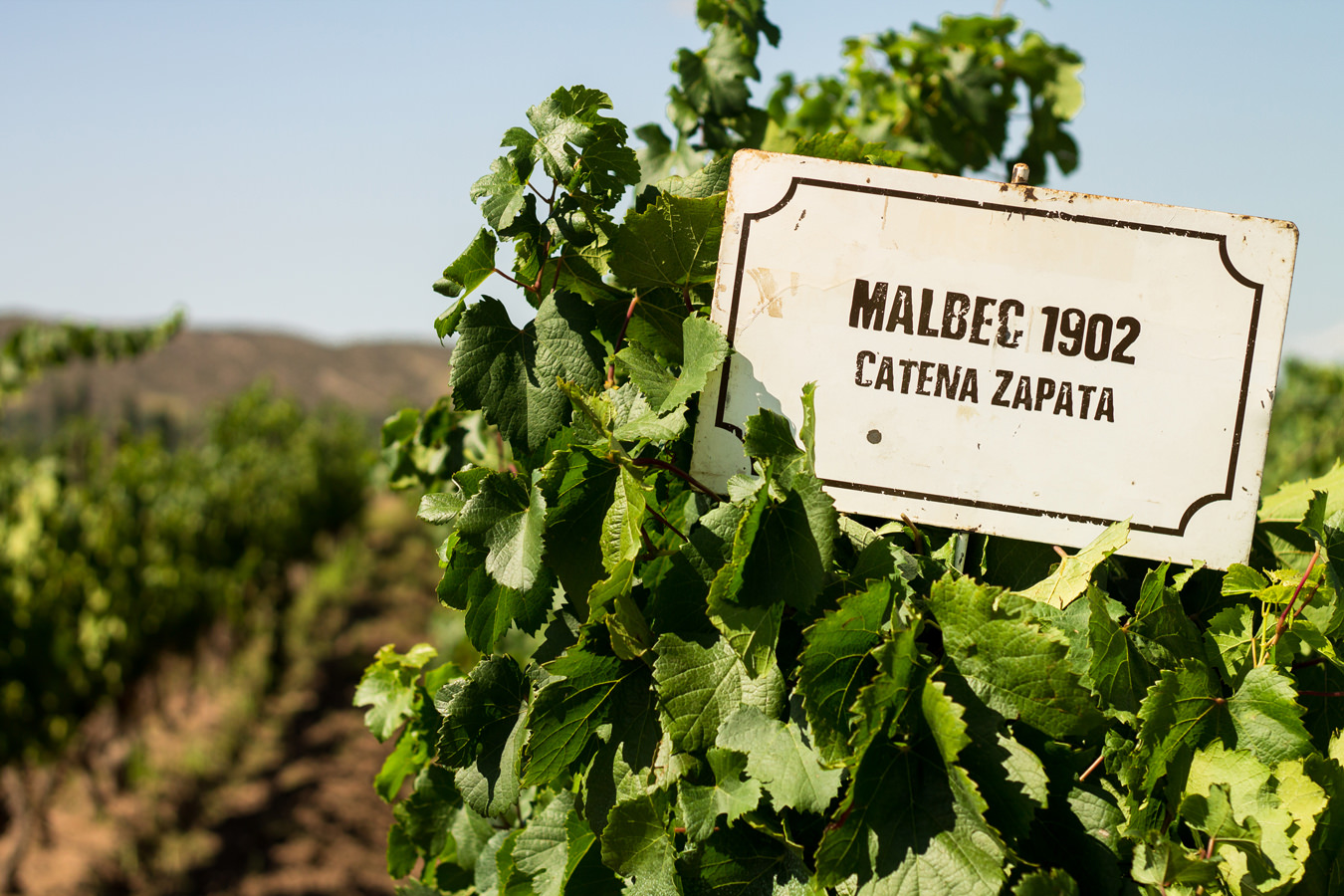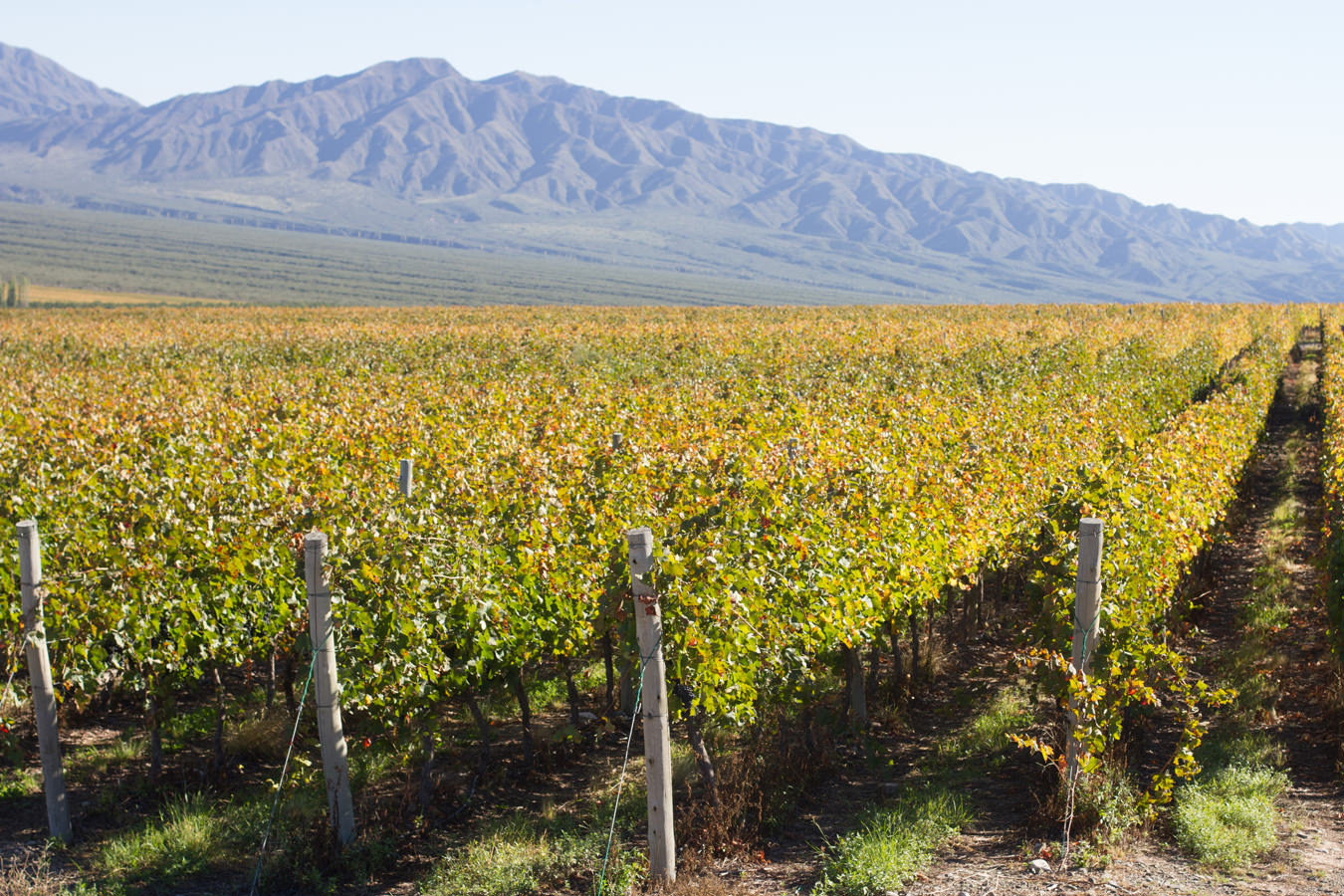-

Bodega Catena Zapata rises like a Mayan temple from the fertile soil.
-

Winemaking goes back to the early 1960s for the familial Zuccardi Vineyards.
-

Malbec vineyards currently account for more than a third of all black-grape vines and cover more than twice the area of the next most planted variety, bonarda.
-

Graffigna produces a number of fine malbecs from high-altitude vineyards.
A History on Malbec
A case of stolen identity?
Malbec is almost a household name these days, but the grape variety suffered from both anonymity and an identity crisis for centuries. It has become widely known only since Argentina put it on the world wine map less than two decades ago. In the late 1990s, waves of inexpensive Argentine malbec began to crash on North American and European markets, and started to give Australian shiraz a run for its money as the world’s most popular, inexpensive, and easy-drinking red wine. Yet although malbec was a new word on the tongues of many wine consumers, wines containing the malbec grape might already have passed their lips many times, labelled with a French appellation or wine region, such as Bordeaux or Cahors, rather than the variety.
In a way, malbec’s history is the success story of an immigrant who left home because prospects were slim there and made it big in another country. Argentina was the other country, while home was southwestern France, where the origins of malbec lie—specifically in the small Cahors (pronounced kah-or) appellation, grown inland from Bordeaux on the river Lot. The first recorded reference to the variety dates to the 16th century, although it wasn’t called malbec then, but Auxerrois. Even now, it is often called cot (or côt) in France and several other names, such as cor, cos, and cau, which are all likely derived from Cahors. It wasn’t recorded as malbec until the 1780s, probably because it was planted in Bordeaux by a Monsieur Malbeck.
Having many aliases is common enough in the world of grape varieties, but things got worse for malbec. Wine made from malbec was being produced in Cahors in the late Middle Ages, and it was shipped downriver to Bordeaux and sold as wine from that region when Bordeaux began its massive wine trade with England in the 1300s. Later, even when Bordeaux’s own vineyards had expanded enough to handle export demand, the city’s wine producers prevented the shipment of Cahors wines until they had sold their own.
In a way, malbec’s history is the success story of an immigrant who left home because prospects were slim there and made it big in another country.
Landlocked and hobbled by Bordeaux’s protectionist policies, Cahors had to wait and sell at a lower price, exploring other markets and ways to reach the northern European market. Now and again, Cahors seemed on the verge of becoming a cult wine. In 1787, the English agronomist Arthur Young visited the region and praised the wines of Cahors as “excellent, full bodied, great spirit, without being fiery, and to my palate much better than our ports.” He ordered a barrel, but when it arrived in England, the wine was off. Who knows? If that wine had arrived in good condition, the history of malbec might have been different because the lucrative English market launched several wine regions, Bordeaux and Champagne among them.
Meanwhile, malbec became one of the permitted red grape varieties grown in Bordeaux, and although it flourished for a few centuries, plantings have decreased. When it is used at all, it generally represents 5 per cent of the blend. It is also planted in other parts of France and in the wider world. Its most important voyage was in the mid-1800s to Argentina, where it was planted in Mendoza, the country’s main wine-producing region. Such was its popularity among Argentines that it became the country’s most planted grape variety; malbec vineyards currently account for more than a third of all black-grape vines and cover more than twice the area of the next most planted variety, bonarda. It has become Argentina’s signature red grape.
Malbec thrives in quite different conditions in southwestern France and Argentina. In Cahors, vines grow in two types of terroirs: alluvial plains in the deep valley, and on modest hillsides and plateaus with a temperate climate moderated by the river Lot. Mendoza is much warmer throughout the year, and grapes grow in many different conditions. Initially vineyards were planted on the plains, but in recent years they’ve been extended to the foothills of the Andes and into much higher elevations. The malbec styles typically produced in Cahors and Argentina are very different, just as other grape varieties make for different wines in different regions (think of primitivo in southern Italy and zinfandel in California or syrah in France’s Rhone Valley and shiraz in Australia’s Barossa Valley).
[Malbec wine] is widely appreciated for the fruity, easy-drinking style promoted by Argentina and the more subdued but approachable style made in Cahors.
In Cahors, malbec can be blended with a little merlot or tannats but must represent at least 70 per cent. The tannat variety is tannic by name and by nature, and blends are now increasingly limited to malbec and merlot. But there’s also a trend toward wines that are exclusively malbec, and Armand de Gérard of the professional association of Cahors producers thinks these 100 per cent malbecs are higher in quality. Blended or not, malbecs from Cahors are often very deeply coloured—these are teeth-staining wines par excellence, if you value stained teeth—and are often so highly tannic when they’re young that they need a little time to integrate.
Many Cahors malbecs have excellent aging potential. A magnum of Château du Cèdre GC from 2005 presents a lot of primary flavours more than 10 years on, with solid structure and supple tannins. A bottle of Château Lagrézette Le Pigeonnier—widely considered one of the finest wines of Cahors—from the same year delivers plush fruit with both depth and breadth, and an excellent balance of all components. Going back even further, a 1998 100 per cent malbec from Domaine du Prince shows little sign of its age as it offers fresh fruit flavours, a soft texture, and clean acidity.
The 200 or so producers of Cahors (plus one co-operative) also make early-drinking malbecs that are more relaxed in tannins to start with, and they’re gaining popularity. (Canada is the top export market for Cahors wines in dollar terms.) But they’re quite unlike the more exuberant and fruity style Argentine producers such as Zuccardi and Trapiche make for the mass market.
Even though Argentina’s upper-tier malbecs (like many New World reds) tend more toward earlier drinking than their Cahors counterparts, they generally deliver plenty of complexity and structure. The flagship red blend of Clos de los Siete, a partnership of French producers in Mendoza, is slightly more than half malbec and is consistently plush textured, rich in fruit, and well structured. Zuccardi also makes malbecs and malbec-dominant wines in the upper tiers. Zuccardi Zeta is up to 87 per cent malbec and has nuanced and well-defined fruit with well-integrated components. Catena, another quality producer, makes single-vineyard malbecs and Catena Zapata Malbec Argentino, all of which are fine examples of what the variety can achieve in Mendoza.
Although malbec was a new word on the tongues of many wine consumers, wines containing the malbec grape might already have passed their lips many times.
Malbec is also cultivated beyond the sprawling Mendoza region. In the fairly arid San Juan wine region to the north, Graffigna produces a number of fine malbecs from high-altitude vineyards. The Grand Reserve level delivers a lot of intensity, with excellent structure and acidity. The latter comes from cool nights, and Graffigna winemaker Ignacio Lopez says the intensity comes from the thicker skins that grapes develop to protect themselves from ultraviolet rays in those conditions. (The flavours, colour, and tannins of wines are mainly derived from the skins.)
Although it’s grown in many parts of the world, malbec is very much a tale of two regions, Cahors and Argentina. They’re unequal in many respects: Argentina has 100,000 acres of malbec compared with a little more than 10,000 acres in Cahors. There was a time when the producers of Cahors resented Argentina’s success withtheir grape, but they now present themselves as the original malbec makers, producing the variety in quite a different style.
Malbec’s is a good story. The variety has had its ups and downs as it has fallen in and out of favour, but right now it is riding a wave of popularity. It is widely appreciated for the fruity, easy-drinking style promoted by Argentina and the more subdued but approachable style made in Cahors, and it is also sought after for the more structured and longer-keeping styles made in both regions. Malbec is a multidimensional grape, and that bodes for a future that is more stable than its past.




